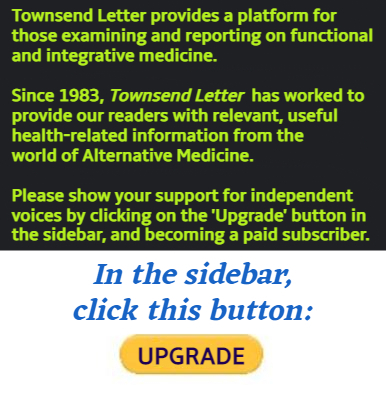An Editorial
by Alan R. Gaby, MD
For many decades, the prevailing opinion in mainstream medicine has been that levothyroxine (T4) is the only appropriate treatment for nearly all patients with hypothyroidism. During that time, some practitioners (including this writer) have held a dissenting opinion. Our view is that a substantial minority of hypothyroid patients respond better to preparations that contain both T4 and triiodothyronine (T3; also called liothyronine) than to products that contain only T4.
It is generally agreed that T3 is the biologically active thyroid hormone and that T4 is a precursor molecule that is converted in the body to T3. The argument used to support the mainstream opinion about thyroid therapy is that the body is capable of converting T4 to T3 at exactly the rate it needs to. Thus, even though the human thyroid gland secretes both T3 and T4, T4 alone is all that is needed for complete thyroid hormone-replacement therapy.
Those of us who hold the dissenting view do so for a simple but important reason. We have seen many patients whose hypothyroid symptoms failed to improve with T4 therapy alone. When these patients were switched to a product that contained both T3 and T4, their symptoms improved dramatically, sometimes in as little as 24 to 48 hours. The T3/T4 product I have used most often is desiccated thyroid extract (DTE), which is an extract from porcine thyroid glands. Other practitioners have seen good results using the combination of synthetic T3 and T4.
A double-blind trial published in 2013 supported the observation that some hypothyroid patients have a better response to DTE than to T4. In that study, 70 patients (aged 18- 65 years) who had been on a stable dose of T4 for at least 6 months were randomly assigned to receive T4 or DTE for 16 weeks, and then the alternate treatment for an additional 16 weeks. After 6 weeks on each regimen, thyroid stimulating hormone (TSH) levels were measured and the dosage was adjusted to maintain a level between 0.5 and 3.0 µIU/ml. Compared with T4, DTE treatment was associated with a trend toward improvement on the general health questionnaire (p < 0.1), the thyroid symptom questionnaire (p = 0.12), and the auditory memory index (p = 0.08). At the end of the study, 34 patients (48.6%) preferred DTE, 13 (18.6%) preferred T4, and 23 (32.9%) had no preference. There were no significant changes in heart rate or blood pressure during the study.1

Two recently published studies provided further support for the idea that combination therapy with T3/T4 is more effective for some people than T4 alone. In one of these studies, 31 hypothyroid patients whose symptoms had failed to improve during treatment with appropriate doses of T4 were switched to DTE. The mean age of the patients was 49.4 years (range, 26-77 years), and the mean length of time since the diagnosis of hypothyroidism was 12.6 years (range, 2-40 years). At the six-month follow-up visit, symptoms had improved in most of the patients, although two patients reported that their symptoms were worse. The magnitude of the improvement in the group as a whole was considered large. Symptoms that frequently improved or resolved included low energy, “brain fog,” sleeping difficulties, depression, and anxiety. Patients also reported they felt more alert and stronger. Two patients discontinued DTE because of cardiac symptoms.2
The other recent study was a double-blind crossover trial. Seventy-five hypothyroid patients (aged 18-65 years) who were on a stable dose of T4 for at least six months were treated in random order with T4, DTE, and a combination of synthetic T3/T4, each for 22 weeks. Six weeks after the start of each treatment period, TSH levels were measured, and the dosage was adjusted to maintain the level between 0.27 and 4.20 µIU/ml. Among the 20 patients who were the most symptomatic at the start of the study, 50% preferred the T3/T4 combination, 35% preferred DTE, 10% preferred T4, and 5% had no preference. Thus, in the subgroup of patients who were not doing well on T4 monotherapy, 85% felt better with a product that contained both T3 and T4. Among those 20 patients, treatments containing T3/T4, as compared with T4 alone, were associated with better scores on the 36-point thyroid symptom questionnaire, the 12-point quality of life general health questionnaire, and the Beck Depression Inventory.3
In 2014, the American Thyroid Association’s Task Force on Thyroid Hormone Replacement updated its guidelines regarding the treatment of hypothyroidism.4 The Task Force concluded that “levothyroxine should remain the standard of care for treating hypothyroidism. We found no consistently strong evidence for the superiority of alternative preparations (e.g., levothyroxine-liothyronine combination therapy, or thyroid extract therapy, or others) over monotherapy with levothyroxine, in improving health outcomes.”
It is well known that around 5-10% of hypothyroid patients continue to experience profound and sometimes disabling symptoms such as fatigue, depression, and impaired cognition, despite receiving T4 in dosages that normalize laboratory tests for thyroid function. In my experience, these patients often fare much better when switched to DTE. Many other patients whose symptoms while on T4 are not profound or disabling also feel better with DTE than with T4.
I believe that the current American Thyroid Association’s practice guidelines lead to substandard care for a substantial minority of hypothyroid patients. DTE has been used for more than 100 years, and anyone who has clinical experience with it knows that in some cases it is clearly more effective than T4 monotherapy. It is time for the practice guidelines to be updated, to acknowledge the appropriateness of using DTE or T3/T4 combinations in selected cases




